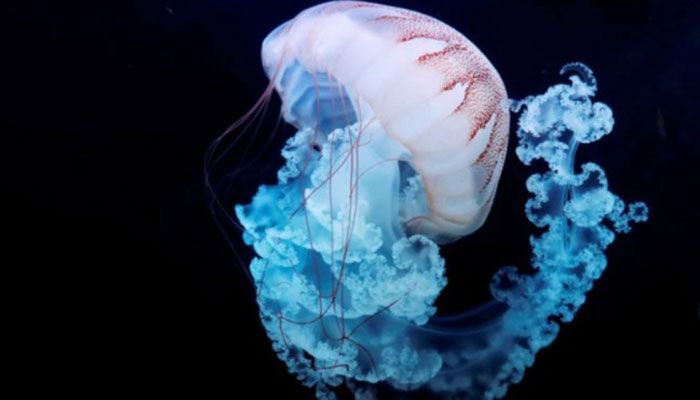
Desk Report
Publish: 29 Nov 2022, 11:09 am

Image: Collected
Jellyfish has always been considered an inedible and therefore useless catch by the fishing communities in the country’s coastal districts. Despite never being considered as commercially viable, new research by Bangladeshi scientists indicates jellyfish can eventually become a source of export earnings, reports UNB.
Like elsewhere, the coast of Bangladesh too plays host to a large number of jellyfish. However, the researchers do not yet know how many jellyfish there are in the waters of Bangladesh. This amount will have to be verified in the research they have now started.
Made up of 90 percent water, jellyfish have no brain, blood, or bones.
Scientists say that the number of jellyfish depends largely on the salinity and temperature of the water. Due to the lack of rain this year, the salinity of the seawater was high, resulting in an abundance of jellyfish washing up on shore.
Md. Rashed-Un-Nabi, Professor, Department of Fisheries, Chittagong University told UNB, "Many countries in the world are researching how to use jellyfish, we have also started research. It shows that it has a lot of economic potential.”
Scientists saw a boom or excess of jellyfish on Patuakhali beach and Cox's Bazar beach in August. At that time, many fishermen were forced to cut their nets because they were filled with jellyfish.
Golam Mostafa, associate professor of Noakhali Science and Technology University (NSTU) said, “We can divide the jellyfish found in the sea of Bangladesh into three categories.”
“One is edible jellyfish. We don't eat it here. But it is in demand as food in Taiwan, Vietnam, Thailand, and China. Each of these jellyfish can weigh up to 8 to 10 kg,” he said.
As a result, it is possible to export to the countries mentioned if extracted commercially, Mostafa said. This type of jellyfish can also be used as raw material for the pharmaceutical and cosmetics industry.
There is another type of jellyfish, which is poisonous. Physical contact with this type can damage a person’s nervous system and lead to paralysis. However it is only a very specific subtype of jellyfish that tends to be poisonous.
The Box Jellyfish, so-called for its box-like physique, is classified as one of the most venomous creatures on Earth, containing toxins that attack the heart, nervous system, and skin cells.
Golam Mostafa observes that fishermen need to be made aware of and trained on this type of jellyfish.
“The damage caused to fishermen is also an economic loss. Many times fishermen do not understand it properly,” he adds.
The third and final type of jellyfish found in Bangladesh is a very small creature. These are used in aquariums or as part of beautification in many countries, he said.
“You can call it recreational use. Many countries, including Thailand, have such aquariums, where palm-shaped transparent jellyfish are kept. The colour of the light you cast becomes that colour. It is a very attractive thing for tourists,'' Golam Mostafa said, an associate professor of NSTU.
He said that the researchers of oceanography and fisheries departments of some universities and the Bangladesh Oceanographic Research Institute (BORI) are researching the potential of jellyfish.
Jellyfish is the main food source for sea turtles. However, although 'fish' is associated with the name, scientists do not consider it a fish because it does not have bones. They consider it plankton (usually microscopic, often less than one inch in length, but they also include larger species like some crustaceans and jellyfish). Although the jellyfish does not have a brain, it has nerves throughout its body.
Researchers have found that jellyfish diverged from other sea creatures billions of years ago when marine life evolved.
Locally in the coastal districts e.g. it is called ‘Nuinna’ in Cox's Bazar - from ‘noon’ meaning salt. Almost the entire body is made of water, which is salty. Therefore the name of the area too is Nuinnachara.
However, the researchers cannot guarantee anything yet - their study will basically be a baseline containing rudimentary information like how many times they played in the World Cup, the size of the jellyfish population, etc.
The eventual export potential depends on a number of factors beyond the novelty factor and enthusiasm.
Subscribe Shampratik Deshkal Youtube Channel
© 2024 Shampratik Deshkal All Rights Reserved. Design & Developed By Root Soft Bangladesh